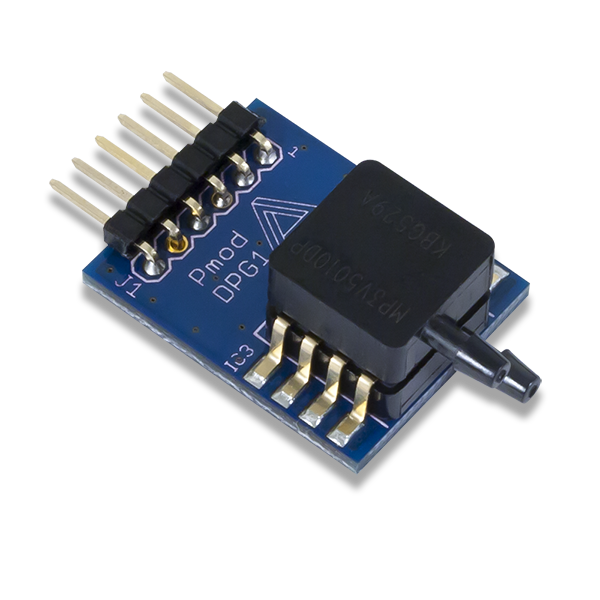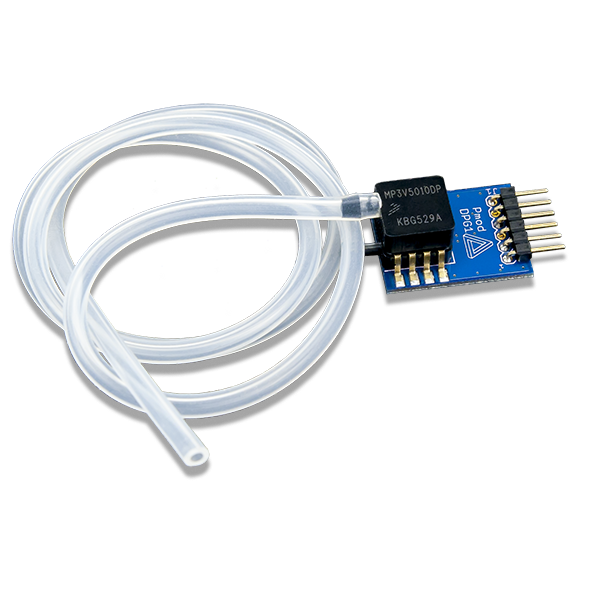
Differential pressure sensors are often used in industrial applications, but they are also great for a number of personal projects. That’s why we’ve added the PmodDPG1 differential pressure gauge to the Pmod sensor family!
The PmodDPG1 is a differential pressure sensor designed for use with dry fluids such as air. It uses NXP’s MP3V5010DP monolithic piezoresistive transducer to sense changes in pressure between two ports. The MP3V5010DP outputs an analog signal proportional to the applied pressure that is accurate within a 5.0% maximum error over 0° to 85° C. The onboard 12-bit ADC then digitizes the signal, maintaining the accuracy of the sensor and allowing for use with a simple SPI interface. Obtaining useful pressure data is then a quick and easy conversion using the equation below.
P (kPa) = (measured ADC value/4096 – 0.08)/0.09
What is differential pressure?
Differential pressure is simply the difference between two applied pressures. This is opposed to gauge pressure which is always measured with reference to atmospheric pressure. For example, if one port of the PmodDPG1 was measuring an applied pressure while the other port was open to the atmosphere, the resulting measurement would actually represent gauge pressure, or absolute pressure (which is always measured with reference to a vacuum). Therefore, if both ports on the sensor are exposed to atmospheric pressure, the PmodDPG1 should output a measurement very close to zero. The graphic below from a National Instruments whitepaper on pressure measurement gives a good visualization of the three types of pressure.

What is a monolithic piezoresistive transducer?
A transducer is simply a device that converts changes in physical quantity to an electrical signal that we can analyze, or vice versa. In the case of a piezoresistive transducer, this conversion happens when the material in the device is mechanically deformed, causing a change in electrical resistivity. This is known as the piezoresistive effect and is leveraged in a range of conventional resistive pressure measurement devices such as strain gauges. Putting monolithic or monocrystalline in front of these two terms technically just means that it is a piece of silicon cut from a single crystal, but what is important to know is that monocrystalline silicon pressure sensors have a higher sensitivity than most other types of pressure sensors and consequently have come into wide use in more recent years.
Now that we have these fancy definitions under our belts, how do we actually use the PmodDPG1?
Applications
The PmodDPG1 is designed to measure a differential pressure range between 0 kPa and 10 kPa. Therefore it is ideally suited for applications such as measuring changes in pressure through a Venturi tube, designing a pressure plate to detect when something touches it. This is much like what is used to trigger a prop spider to drop when trick or treaters have stepped on your porch during Halloween. It can also be used to determine pressure exerted by the human lung.
However, all of these applications require measuring applied pressure at two different points that are likely farther apart than a few millimeters. For this reason, the PmodDPG1 ships with a 61 cm polyvinyl tube that fits snugly over either port on the sensor.
It is important to note that the PmodDPG1 should not be used to measure bike or car tire pressure, since both of these applications require a differential measurement of over 200 kPa.

Getting Started
To use the PmodDPG1, the raw data from the sensor needs to be converted to a useful measurement. To get users started quickly, we’ve written an MPIDE library and example code that converts the raw data to several different units of pressure such as psi and mmHG. See the PmodDPG1 Digilent wiki page to download.
If using the PmodDPG1 with a Digilent FPGA board, see our wiki page titled Using Pmod IP’s for instructions on how to get up and running smoothly with MicroBlaze designs.
Questions or comments? Use the comment section below or visit the Digilent Forum!
Sources:


like!! I always blog and I sincerely thank you for your knowledge. The blog really increased my curiosity.